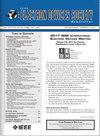Design and Optimization of Bilayer InGaSnO and Nitrogen-Doped InSnO Thin-Film Transistors for Enhanced Mobility and Reliability
IF 2.4
3区 工程技术
Q3 ENGINEERING, ELECTRICAL & ELECTRONIC
引用次数: 0
Abstract
In this study, high-performance indium gallium tin oxide (IGTO) and nitrogen (N) doped indium tin oxide (ITO) hetero structured bilayer thin-film transistors (TFTs) are prepared by incorporating an N-doped ITO intercalation layer in single-layer IGTO TFTs. The performance of the IGTO/ITO:N bilayer TFTs is significantly improved compared with single-layer IGTO TFTs, with specific indicators including a field-effect mobility of 32.6 cm2/V双层InGaSnO和氮掺杂InSnO薄膜晶体管的设计与优化,以提高迁移率和可靠性
在本研究中,通过在单层IGTO薄膜晶体管中加入N掺杂ITO嵌入层,制备了高性能的铟镓锡氧化物(IGTO)和氮掺杂铟锡氧化物(ITO)异质结构双层薄膜晶体管(TFTs)。与单层IGTO TFTs相比,IGTO/ITO:N双层TFTs的性能得到了显著提高,具体指标包括场效应迁移率为32.6 cm2/V $\cdot $ s,亚阈值摆幅为201 mV/dec,在±10 V栅极偏置应力下阈值电压位移为0.21 V和- 0.45 V。结果表明,性能的提高是由于双层结构的合理设计,其中ITO层作为电荷积累层,提供额外的电子。同时,N掺杂有效地减少了氧空位,从而降低了界面陷阱密度,最终提高了单层IGTO tft的性能。通过x射线光电子能谱和低频噪声分析,我们进一步证实了N掺杂和双层结构对减少缺陷态和提高tft稳定性的积极作用。总的来说,本文提出的策略对于制备高性能氧化物tft在未来光电显示中的潜在应用是有效的。
本文章由计算机程序翻译,如有差异,请以英文原文为准。
求助全文
约1分钟内获得全文
求助全文
来源期刊

IEEE Journal of the Electron Devices Society
Biochemistry, Genetics and Molecular Biology-Biotechnology
CiteScore
5.20
自引率
4.30%
发文量
124
审稿时长
9 weeks
期刊介绍:
The IEEE Journal of the Electron Devices Society (J-EDS) is an open-access, fully electronic scientific journal publishing papers ranging from fundamental to applied research that are scientifically rigorous and relevant to electron devices. The J-EDS publishes original and significant contributions relating to the theory, modelling, design, performance, and reliability of electron and ion integrated circuit devices and interconnects, involving insulators, metals, organic materials, micro-plasmas, semiconductors, quantum-effect structures, vacuum devices, and emerging materials with applications in bioelectronics, biomedical electronics, computation, communications, displays, microelectromechanics, imaging, micro-actuators, nanodevices, optoelectronics, photovoltaics, power IC''s, and micro-sensors. Tutorial and review papers on these subjects are, also, published. And, occasionally special issues with a collection of papers on particular areas in more depth and breadth are, also, published. J-EDS publishes all papers that are judged to be technically valid and original.
 求助内容:
求助内容: 应助结果提醒方式:
应助结果提醒方式:


